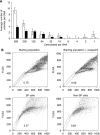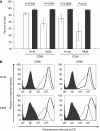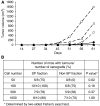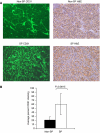Molecular characterisation of side population cells with cancer stem cell-like characteristics in small-cell lung cancer
- PMID: 20424609
- PMCID: PMC2883147
- DOI: 10.1038/sj.bjc.6605668
Molecular characterisation of side population cells with cancer stem cell-like characteristics in small-cell lung cancer
Abstract
Background: Side population (SP) fraction cells, identified by efflux of Hoechst dye, are present in virtually all normal and malignant tissues. The relationship between SP cells, drug resistance and cancer stem cells is poorly understood. Small-cell lung cancer (SCLC) is a highly aggressive human tumour with a 5-year survival rate of <10%. These features suggest enrichment in cancer stem cells.
Methods and results: We examined several SCLC cell lines and found that they contain a consistent SP fraction that comprises <1% of the bulk population. Side population cells have higher proliferative capacity in vitro, efficient self-renewal and reduced cell surface expression of neuronal differentiation markers, CD56 and CD90, as compared with non-SP cells. Previous reports indicated that several thousand SP cells from non-small-cell lung cancer are required to form tumours in mice. In contrast, as few as 50 SP cells from H146 and H526 SCLC cell lines rapidly reconstituted tumours. Whereas non-SP cells formed fewer and slower-growing tumours, SP cells over-expressed many genes associated with cancer stem cell and drug resistance: ABCG2, FGF1, IGF1, MYC, SOX1/2, WNT1, as well as genes involved in angiogenesis, Notch and Hedgehog pathways.
Conclusions: Side population cells from SCLC are highly enriched in tumourigenic cells and are characterised by a specific stem cell-associated gene expression signature. This gene signature may be used for development of targeted therapies for this rapidly fatal tumour.
Figures





References
-
- Al Hajj M, Clarke MF (2004) Self-renewal and solid tumor stem cells. Oncogene 23: 7274–7282 - PubMed
-
- Behbod F, Xian W, Shaw CA, Hilsenbeck SG, Tsimelzon A, Rosen JM (2006) Transcriptional profiling of mammary gland side population cells. Stem Cells 24: 1065–1074 - PubMed
-
- Caussinus E, Gonzalez C (2005) Induction of tumor growth by altered stem-cell asymmetric division in Drosophila melanogaster. Nat Genet 37: 1125–1129 - PubMed
-
- Collins AT, Berry PA, Hyde C, Stower MJ, Maitland NJ (2005) Prospective identification of tumorigenic prostate cancer stem cells. Cancer Res 65: 10946–10951 - PubMed
Publication types
MeSH terms
Substances
Grants and funding
LinkOut - more resources
Full Text Sources
Medical
Research Materials
Miscellaneous

